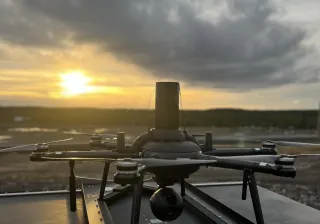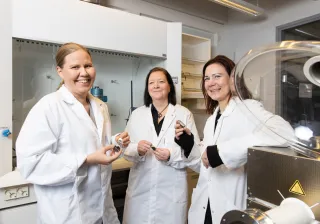VTT, in collaboration with other stakeholders in the sector, aims to promote the growth of unmanned aviation business through versatile technology and business research with the goal of creating a diverse industry in Finland for new, growing international markets. The Innovative Air Mobility as Operator Business (AIMO) project led by VTT examined the preconditions for the unmanned aviation fleet operator business from the perspectives of demand and the service offering. The term fleet operator refers to operators who are responsible for operating an entire drone fleet. During the project, a joint future vision that will allow actors in the sector to start developing the future in a common direction, was created. As a result of the project, proposals for actions that public administration can implement to support realisation of the vision were produced.
Operator business supports the entire value network in fast-growing markets
According to the vision created in the project, Finland will be a global pioneer in the rapidly growing unmanned aviation market, and a new ecosystem based on dual-use principles will be developed in the country to produce aviation solutions for the civil and defence industries. Fleet operators will provide the capabilities needed for drone services so that various service providers can easily and efficiently produce carbon-neutral logistics and aerial imaging services for public and private organisations and consumers in urban and rural areas. An example of multi-purpose drone use is that a drone that is transporting goods for customer A simultaneously images the environment along its route to update the digital model for customer B and also observes an industrial site owned by customer C, where a safety alarm has gone off. With support from fleet operators, affordable services that include transporting e-commerce orders directly to homes will also be provided to consumers. This multi-purpose feature will allow fleet operators to operate their drones 24/7 at a high utilisation rate and provide scalable benefits for all actors in the value network. Safety features, such as collision prevention, communication connections and mechanisms for managing fault situations, will be standardised, particularly in densely populated areas. Drone traffic in the urban airspace will be widely accepted by citizens, and drones will also be used in cooperation between authorities.
Global challenges and needs in the sector represent opportunities for Finland
The specific challenges in the sector include the slow growth of business operations, unrealised nature of scalable benefits, and the demographic and climatic conditions in Finland – such as sparsely populated areas, long distances and varying weather conditions. Regulation of the safety-critical aviation sector set by the European Union Aviation Safety Agency (EASA) and Traficom and the need to improve acceptance also present their own challenges. Insurance and liability issues and possible business disruption, in which large global players can hijack the market, increase uncertainty in the sector. From the business perspective, ground operations – such as loading, unloading, maintenance and safety – are just as important as the actual flying and new infrastructure as well as changes to existing infrastructure are needed at drone landing and loading sites. Enabling U-space/CIS services (lower airspace air traffic control) and autonomous BVLOS (Beyond Visual Line Of Sight) remote operations will significantly increase the productivity.
Challenges can be turned into opportunities. One way to do it is to get a sufficient number of actors who believe in the growing business of drone solutions activated throughout the value network in Finland. The fleet operator business model that is the main target of the AIMO project makes business growth possible. This business model is expected to lead to the emergence of several competing fleet operators in Finland, which will offer large drone fleets operating over extensive geographic areas, needed equipment and ground infrastructure as well as the support staff for operations – including pilots, marketing, sales, administration and ground service production personnel.
Long-term collaboration between private and public sector actors and authorities is needed to promote the creation of new business opportunities. It is particularly important to involve risk financiers alongside the research and development projects because this will enable the rapid development of technologies and alternative platform economy business models towards new, growing and international business. Once succeeded, it will also produce interesting new professions and jobs throughout the country.
As a result of AIMO project, proposals for actions were recognized. These proposals help us in the way towards the future vision and enhance in promoting the unmanned aviation business in Finland.
Proposals for actions produced during the AIMO project:
- A joint official request for information/request for quote process (“RFI-RFQ”) supported by VTT and led by municipalities and cities in order to assess demand and supply for public and private sector services and test the service offering and future fleet operator business model.
- Production of planning instructions for municipalities related to land use planning, structural matters and dimensions for implementing ground operations as urban cooperation with the support of VTT.
- A more extensive research and development project portfolio for implementing ground operations led by VTT, with the goal of making Finland a pilot country in terms of reaching international markets.
- VTT's ongoing LUC (Light UAS operator certificate) certification process, which enables versatile business-based experiments for companies participating in service production throughout Finland. In addition, VTT can serve as a temporary service provider with partners in establishing U-space/CIS services (air traffic control) to create the preconditions for BVLOS operations in an extensive operating area.
- The results of AIMO project should be taken into consideration in the Airspace 2027 reform preparation work.
The AIMO project was carried out during January–June 2024. The participants and funders of the project were seven cities: Espoo, Helsinki, Mikkeli, Oulu, Rovaniemi, Seinäjoki and Tampere as well as seven companies: Anarky Labs, Eminus Industries, Fimlab, Flyk, Jotus, Sitowise and Tuomi Logistics. Innoavia and Fintraffic ANS were also actively involved in implementation of the project.




